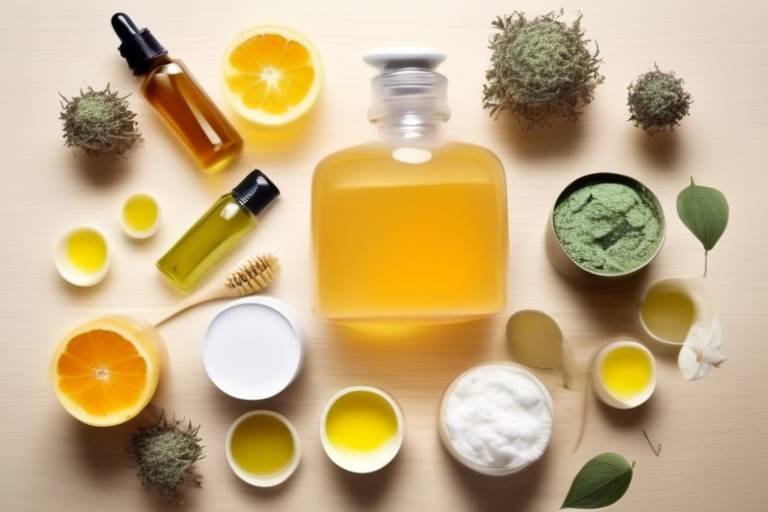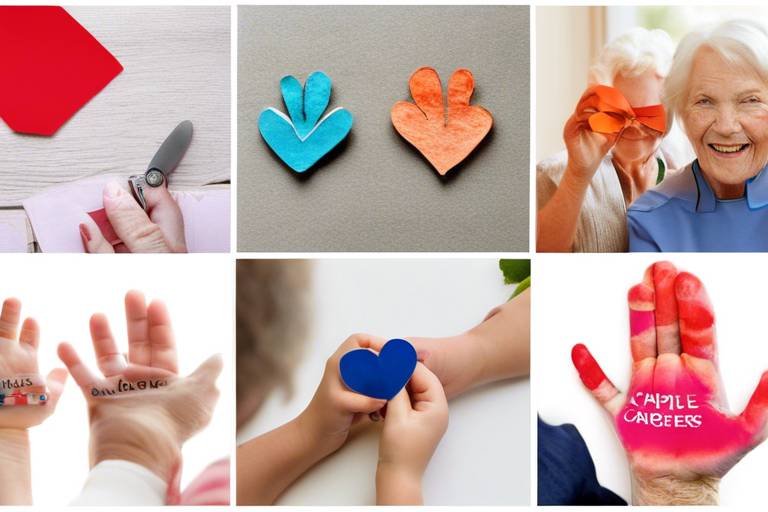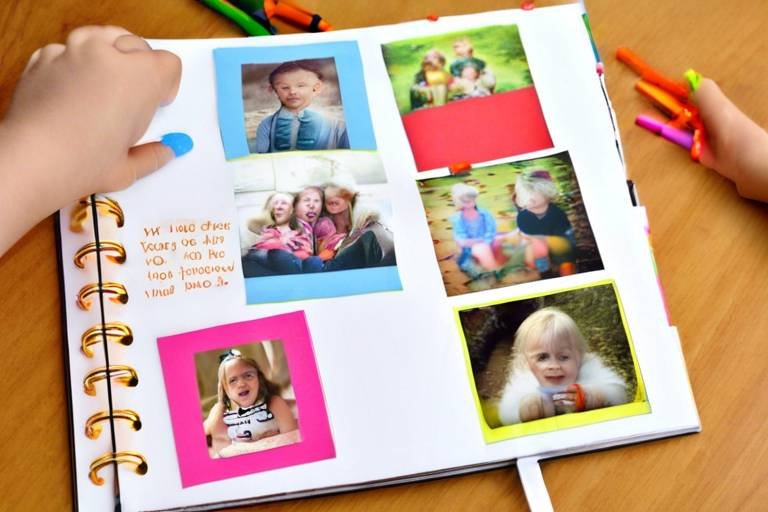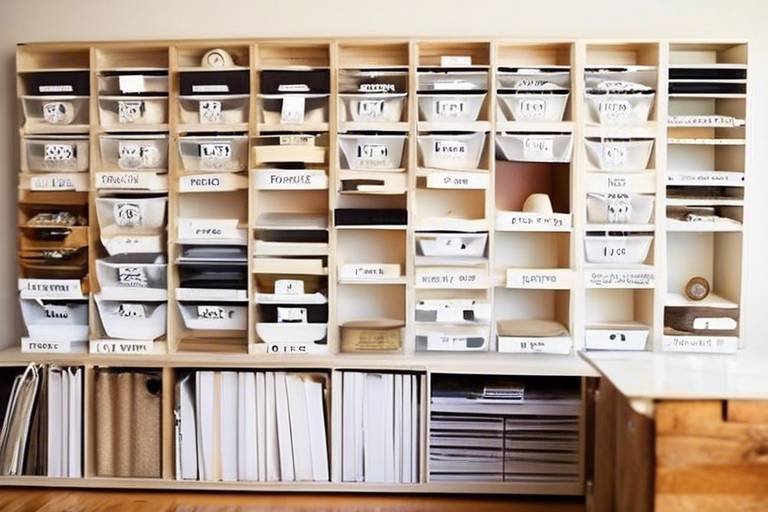Crafting with Kids - 10 Easy DIY Science Projects
Are you looking for fun and educational activities to do with your kids? Look no further than these 10 easy DIY science projects that are perfect for crafting with kids. From exploring physics to chemistry and biology, these projects offer a hands-on way for children to learn about science while having a blast.
Let's start with the Balloon Rocket project, a simple yet fascinating experiment that demonstrates Newton's Third Law of Motion in action. By setting up a balloon rocket, kids can witness the principles of physics firsthand in a fun and engaging way.
Next up is the Homemade Lava Lamp, a visually mesmerizing project that explores the science of density and chemical reactions. Using household ingredients, kids can create their own lava lamp and observe the captivating interaction between oil and water.
For a burst of color and creativity, try the Rainbow Paper project, which involves chromatography to separate colors in markers and create beautiful rainbow patterns. This project not only teaches kids about solvents and pigments but also allows them to express their artistic side.
DIY Slime is a favorite among kids, offering a squishy and stretchy material to play with while learning about non-Newtonian fluids and polymer chemistry. It's a hands-on way to explore science through sensory play.
Get ready to be amazed by Egg Geodes, where kids can create stunning crystal-filled geodes using common kitchen ingredients. This project delves into the science of crystal formation and provides a unique hands-on experience for young geologists.
Unleash your inner spy with Invisible Ink Messages, a project that involves revealing hidden messages using homemade invisible ink made from lemon juice or baking soda solution. Kids can explore the science of acids and bases while having fun with secret codes.
Combine science and dessert with Solar Oven S'mores, a project that teaches kids about solar energy and heat transfer while making delicious s'mores. It's a tasty way to learn about renewable energy sources in a hands-on manner.
Quench your thirst with Fizzy Lemonade, a project that mixes baking soda and citric acid to create a fizzy reaction in lemonade. Kids can explore chemical reactions and carbonation while enjoying a refreshing drink.
Observe the magic of plant growth with Seed Jar Science, where kids can witness the germination process up close by growing seeds in a jar with wet paper towels. This project teaches children about the importance of water and sunlight for plant growth in a simple yet impactful way.

1. Balloon Rocket
Are you looking for fun and educational activities to do with your kids at home? Dive into the world of science with these 10 easy do-it-yourself projects that will spark curiosity and creativity in young minds. Let's explore the wonders of physics, chemistry, and biology through hands-on experiments that are both entertaining and enlightening.
Embark on a thrilling journey into the realm of physics with a simple yet exciting balloon rocket experiment. By demonstrating Newton's Third Law of Motion, kids can witness the equal and opposite reaction in action. All you need is a balloon, a straw, some string, and a bit of tape to set up this high-flying project. Watch as the balloon propels forward, teaching valuable lessons about force and motion in a fun and engaging way.
Want to take this experiment to the next level? Create a race track using a long piece of string or fishing line, challenge your kids to design the fastest rocket, and let the friendly competition begin. Encourage them to make predictions, observe the results, and draw conclusions based on their observations. Who knew learning about physics could be this exhilarating?
As your balloon rocket zooms across the room, imagine the thrill of discovery lighting up your child's eyes. The sheer joy of witnessing scientific principles come to life through a hands-on activity is a priceless experience that will leave a lasting impact on their young minds. So, grab your balloons and get ready to launch into a world of exploration and excitement!
Have some burning questions about these DIY science projects? Check out our FAQs below:
- Q: Are these projects safe for kids to do at home?
- A: Yes, all the projects mentioned in this article use safe and common household materials. However, adult supervision is recommended, especially for younger children.
- Q: Can these activities be adapted for different age groups?
- A: Absolutely! You can modify the complexity of the projects based on the age and skill level of your child. Feel free to tailor the experiments to suit your child's interests and abilities.
- Q: How can I incorporate educational concepts into these projects?
- A: Each project is designed to introduce fundamental scientific principles in a hands-on and interactive way. Use the experiments as a springboard for discussions about various scientific concepts and encourage your child to ask questions and explore further.

2. Homemade Lava Lamp
Making a homemade lava lamp is an exciting and visually captivating project that kids will love to create. By using simple household ingredients, you can explore the fascinating science of density and chemical reactions in a fun and engaging way. The mesmerizing lava lamp effect is achieved through the interaction of oil and water, creating mesmerizing blobs that move around like a lava lamp.
To create your homemade lava lamp, you will need a clear bottle or container, water, vegetable oil, food coloring, and effervescent tablets such as Alka-Seltzer. Start by filling the container with water, leaving some space at the top. Next, pour vegetable oil into the container, filling it almost to the brim. Add a few drops of food coloring to the oil to create vibrant colors that will stand out against the water.
Once you have added the food coloring, break an effervescent tablet into smaller pieces and drop them into the container. As the tablet reacts with the water, it will release carbon dioxide bubbles that carry droplets of colored water up through the oil, creating the mesmerizing lava lamp effect. Watch as the colorful blobs rise and fall, creating a dynamic display of colors and shapes.
This DIY lava lamp project is not only entertaining but also educational. It provides a hands-on way for kids to learn about density, immiscible liquids, and chemical reactions. By observing the movement of the colorful blobs, children can gain a better understanding of how different substances interact with each other and the principles behind the lava lamp's mesmerizing display.

3. Rainbow Paper
When it comes to engaging kids in the wonders of science, creating colorful and interactive projects is the way to go. One such project that never fails to impress is making Rainbow Paper. This activity involves a fascinating process called chromatography, where colors are separated to form beautiful rainbow patterns. By using markers and a few simple household items, kids can explore the science behind solvents and pigments in a creative and hands-on way.
To start the Rainbow Paper project, all you need are some washable markers, coffee filters or paper towels, a shallow dish, and water. Begin by drawing colorful lines or dots on the filter paper with the markers. The next step is to carefully dip the bottom of the paper into the water, allowing the colors to spread and separate. As the water travels up the paper, it carries the pigments along, creating a stunning display of vibrant hues.
Through this experiment, children can witness how different colors are composed of various pigments that move at different rates when dissolved in water. The slower-moving pigments will be left behind, forming distinct bands of color on the paper. It's a magical sight to see the rainbow emerge before their eyes, sparking curiosity and excitement about the science behind it.
Moreover, this project offers a fantastic opportunity to discuss the concept of solubility and how different compounds interact with each other. Kids can observe firsthand how the solvent (water) interacts with the pigments in the markers, leading to the separation of colors. It's a simple yet effective way to introduce them to the fascinating world of chemistry in a fun and accessible manner.
Encouraging children to experiment with Rainbow Paper not only fosters their creativity but also enhances their understanding of scientific principles. By engaging in hands-on activities like this, kids can develop a genuine interest in science while having a blast creating their own colorful masterpieces. So, gather your materials, unleash your inner artist, and get ready to explore the magic of chromatography with Rainbow Paper!

4. DIY Slime
DIY Slime is a popular and engaging project that not only provides hours of entertainment but also teaches kids about science. By mixing simple ingredients, children can create a squishy and stretchy substance known as slime. This hands-on activity introduces young minds to the concept of non-Newtonian fluids and polymer chemistry in a fun and interactive way.
One of the key components in making DIY slime is a type of polymer called polyvinyl acetate, commonly found in white glue. When combined with a solution of water and borax or contact lens solution, the polymer chains in the glue cross-link to create a unique texture that is both solid and liquid at the same time. This property allows the slime to be molded and shaped, providing endless possibilities for creative play.
Children can customize their slime by adding colors, glitter, or even small toys to create different textures and effects. Experimenting with the slime's consistency by adjusting the amount of ingredients can also be a valuable lesson in following instructions and understanding the basics of chemical reactions.
Moreover, DIY slime encourages sensory exploration as kids engage their sense of touch and sight while playing with the colorful and gooey substance. The process of making slime can also foster curiosity and critical thinking as children observe how the ingredients transform into a new material with unique properties.
Overall, DIY slime is a fantastic project that combines creativity, science, and fun, making it a perfect choice for crafting with kids and sparking their interest in the wonders of chemistry.

5. Egg Geodes
Creating stunning crystal-filled egg geodes is a fascinating project that not only captivates the eyes but also teaches kids about the science of crystal formation. By using common kitchen ingredients, such as Epsom salt, alum powder, and food coloring, children can observe the magical process of crystals growing inside eggshells. This hands-on activity allows young geologists to explore the concept of supersaturated solutions and crystal nucleation.
Start by carefully cracking open raw eggs and emptying them to create hollow shells. Then, prepare a supersaturated solution by dissolving Epsom salt and alum powder in hot water. Add food coloring to the solution to create vibrant crystal colors. Place the empty eggshells in an egg carton and carefully pour the solution into each shell. As the solution cools and evaporates, crystals will gradually form inside the shells, resembling natural geodes.
Through this project, children can witness the gradual growth of crystals and understand the role of factors such as temperature and saturation in crystal formation. The intricate patterns and colors of the crystals will spark curiosity and wonder, making the egg geode experiment a memorable and educational experience for young minds.

6. Invisible Ink Messages
Have you ever wanted to send secret messages that only your intended recipient could decipher? With the Invisible Ink Messages DIY project, you can explore the fascinating world of hidden communication using everyday household items. By creating your own invisible ink from simple ingredients like lemon juice or baking soda solution, you can uncover hidden messages and learn about the science of acids and bases in an interactive and fun way.
This hands-on activity not only sparks curiosity but also introduces children to the concept of chemical reactions in a playful manner. As they write with the invisible ink and watch their messages appear when heat is applied or special techniques are used, they are engaging with scientific principles without even realizing it. It's a clever blend of mystery and education that will leave kids eager to experiment further.
Imagine the excitement on their faces as they discover the hidden words slowly emerging on the paper, as if by magic. This project encourages critical thinking and problem-solving skills as children explore different methods to reveal the concealed messages. It's a perfect way to combine creativity with science, making learning an enjoyable and memorable experience.

7. Solar Oven S'mores
Imagine the sun's rays transforming into a delicious treat right before your eyes - that's the magic of Solar Oven S'mores! This fun and educational project not only satisfies your sweet tooth but also teaches you about solar energy and heat transfer. By harnessing the power of the sun, you can create mouthwatering s'mores while exploring the fascinating world of science.
To embark on this culinary adventure, you will need a few simple materials such as a cardboard box, aluminum foil, plastic wrap, and of course, the essential s'mores ingredients - graham crackers, chocolate, and marshmallows. The process involves constructing a solar oven using the cardboard box lined with aluminum foil to reflect and trap the sun's heat, creating a warm environment perfect for melting the chocolate and toasting the marshmallows.
As you assemble your solar oven and wait for the sun to work its magic, you can discuss with your young scientists the concepts of solar energy and heat transfer. How does the sun's energy transform into heat within the oven? What materials are best at absorbing and retaining this heat? These questions spark curiosity and encourage a deeper understanding of the science behind this tasty experiment.
Once your solar oven has done its job and the s'mores are gooey and irresistible, it's time to enjoy the fruits of your labor. The combination of melted chocolate, toasted marshmallows, and crispy graham crackers is a delightful reward for both your taste buds and your newfound knowledge of solar energy.

8. Fizzy Lemonade
Let's dive into the exciting world of fizzy lemonade! This DIY project is not just about making a refreshing drink but also about exploring the wonders of chemical reactions. By mixing baking soda and citric acid, you can create a delightful fizzy reaction that will not only tickle your taste buds but also teach you about the science behind carbonation.
Imagine the joy on a child's face as they witness the lemonade bubbling and fizzing right before their eyes. It's like a mini science experiment in a glass, where every sip is a burst of flavor and fun. This project is a perfect blend of education and enjoyment, making learning about chemical reactions a delicious experience.
As you mix the ingredients and see the lemonade transform into a fizzy concoction, you'll be amazed at how simple household items can create such an exciting reaction. It's a hands-on way to understand the principles of chemistry while quenching your thirst with a zesty drink.

9. Seed Jar Science
Exploring the wonders of nature through hands-on experiments can be an exciting and educational experience for kids. In the Seed Jar Science project, children get to witness the magic of plant growth up close. By growing seeds in a jar with wet paper towels, they can observe the germination process in action. This project not only teaches them about the importance of water and sunlight for plants but also instills a sense of curiosity and wonder about the natural world.
As the seeds begin to sprout and grow roots, kids can witness firsthand how plants develop and thrive. It's a simple yet fascinating way to learn about biology and botany in a controlled environment. By observing the different stages of plant growth, children can gain a deeper appreciation for the intricate processes that sustain life on Earth.
Moreover, the Seed Jar Science project provides a hands-on opportunity for kids to take care of living organisms and understand the basic needs of plants. By ensuring that the seeds have enough moisture and light to grow, children learn about the responsibilities of nurturing living things. This project not only fosters a sense of responsibility but also encourages empathy and respect for nature.
Through the Seed Jar Science experiment, children can develop important scientific skills such as observation, data recording, and analysis. By documenting the growth of the seeds over time, kids can practice scientific methods and draw conclusions based on evidence. This project lays the foundation for a lifelong interest in science and encourages young minds to explore the wonders of the natural world.
Frequently Asked Questions
- Can these DIY science projects be done with kids of all ages?
Yes, the DIY science projects featured in this article are designed to be engaging and educational for kids of various ages. Younger children may need more guidance and supervision, while older kids can explore the concepts in more depth.
- Are the materials for these projects easy to find?
Absolutely! Most of the materials used in these DIY science projects are common household items that you likely already have on hand. Simple things like markers, baking soda, lemon juice, and eggs are all you need to get started.
- Do these projects require any special skills or knowledge?
No special skills or prior knowledge is necessary to complete these projects. The instructions are easy to follow, and the projects are designed to be hands-on learning experiences that anyone can enjoy.
- How can these projects benefit my child?
These DIY science projects not only provide a fun way for kids to learn about scientific concepts but also help develop critical thinking skills, creativity, and a love for exploration. They encourage curiosity and a deeper understanding of the world around them.



















